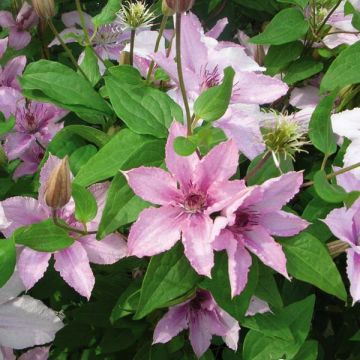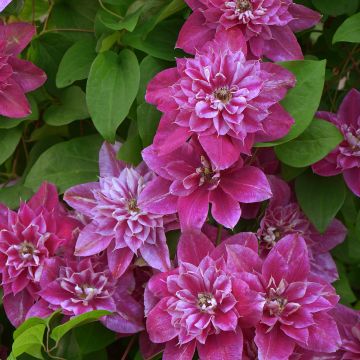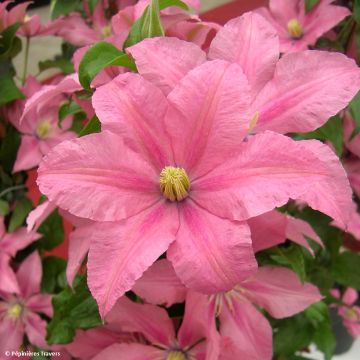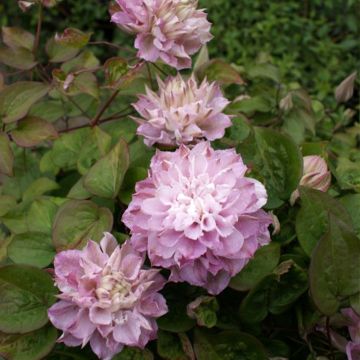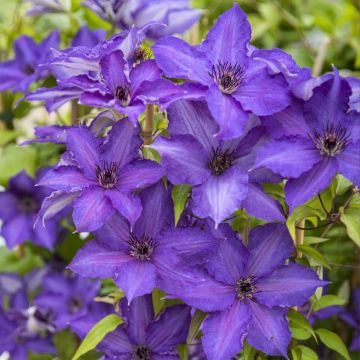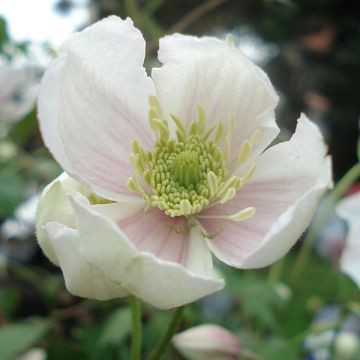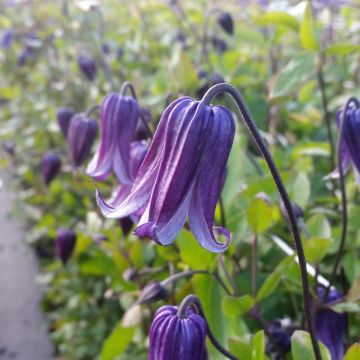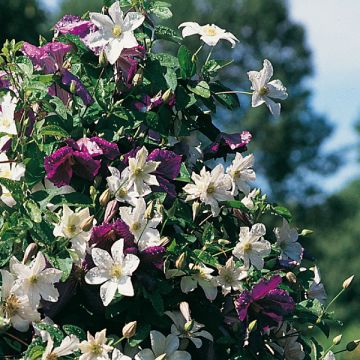Shipping country and language
Your country of residence may be:
Your country of residence is:
For a better user experience on our website, you can select:
Your shipping country:
Andorra
Austria
Belgium
Bulgaria
Canada
Chile
Croatia
Cyprus
Czechia
Denmark
Estonia
Finland
France
Germany
Greece
Hungary
Iceland
Ireland
Italy
Latvia
Lithuania
Luxembourg
Malta
Monaco
Netherlands
Poland
Portugal
Romania
Slovakia
Slovenia
Spain
Sweden
Switzerland
United Kingdom
We only deliver seed and bulb products to your country. If you add other products to your basket, they cannot be shipped.
Language:
French
German
Spanish
English
My Account
Hello
My wish lists
Plantfit
Log in / Register
Existing customer?
New customer?
Create an account to track your orders, access our customer service and, if you wish, make the most of our upcoming offers.
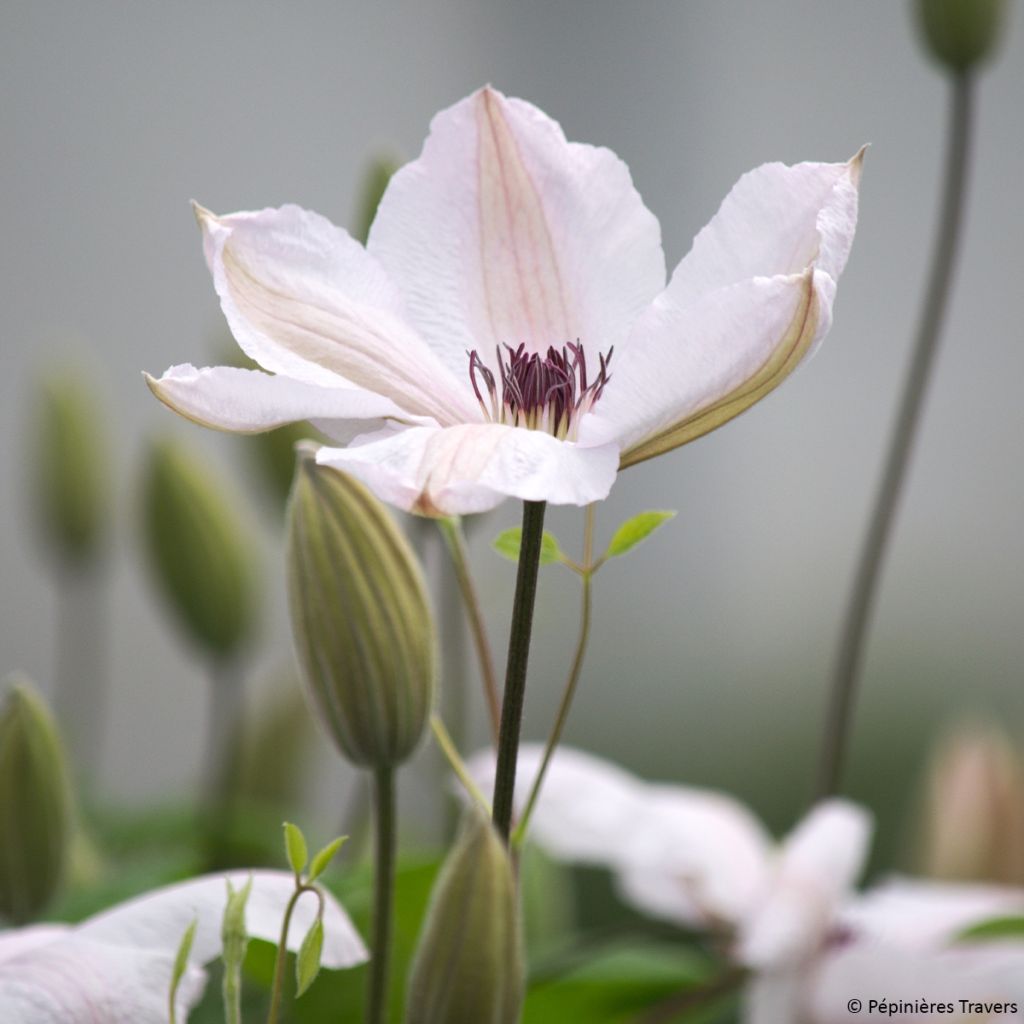

Clematis 'Jan Pawel II'


Clematis 'Jan Pawel II'
Clematis 'Jan Pawel II'
Clematis patens 'Jan Pawel II'
Early Large-flowered Clematis
Why not try an alternative variety in stock?
View all →Order in the next for dispatch today!
Dispatch by letter from €3.90.
Delivery charge from €5.90 Oversize package delivery charge from €6.90.
More information
This item is not available in your country.
Schedule delivery date,
and select date in basket
This plant carries a 6 months recovery warranty
More information
We guarantee the quality of our plants for a full growing cycle, and will replace at our expense any plant that fails to recover under normal climatic and planting conditions.
From €5.90 for pickup delivery and €6.90 for home delivery
Express home delivery from €8.90.
Does this plant fit my garden?
Set up your Plantfit profile →
Description
Clematis Jan Pawel II, also marketed as John Paul II, is a popular Polish variety, with vigorous growth that offers abundant flowering in June-July, and again in late summer. Its large single corollas are white with red stamens, and a pink central zone, with the pink being more pronounced in partial shade, and in late summer. Romantic and luminous, this beautiful climber is perfect for dressing up a tree, a fence, a pergola, or a bush...
Clematis belong to the renunculaceae family. The 'Jan Pawel II' variety, obtained in Poland before 1981 by Brother Stefan Franczak, is a descendant of Clematis patens, an Asian species with large flowers of varying colours, which has given rise to numerous cultivars. It is a perennial and hardy, semi-woody climber which reaches about 3.50 m (11ft) high (sometimes up to 5 m (16ft)), with a minimum spread of 1.25 m (4ft). This 'Jan Pawel II' variety develops new shoots in spring, from buds located on older stems. Each stem produces a flower bud that blooms in June-July then a second flowering occurs on the young shoots in late summer. This variety has rounded flowers with eight petals, about 15 cm (6in) wide. The September flowers often have only six petals, but they are pinker. The corollas are erect and have a cluster of red stamens in their centre, which contrast wonderfully with the white petals crossed by a pink central line. The flowers are followed by decorative silvery grey feathery seed heads that persist until winter. The deciduous leaves are divided into 3 or more fairly deep green leaflets. This clematis clings to the support or host plant on its own through petioles transformed into tendrils. Its deciduous foliage dries up in winter.
Plant clematis alongside your climbing roses or ramblers to extend the flowering of your walls and pergolas until the end of summer. Place pretty perennials like geraniums, carnations, nemorosa perennial sage or phlox at their base, to provide the shade it likes. This is a diverse genus, with varieties of all colours, shapes, and sizes. Take advantage of their easy cultivation to give your garden a romantic and bohemian touch. 'Jan Pawel II' loves to weave itself into bushes. It thrives in partial shade.
Clematis 'Jan Pawel II' in pictures


Plant habit
Flowering
Foliage
Botanical data
Clematis
patens
'Jan Pawel II'
Ranunculaceae
Early Large-flowered Clematis
Cultivar or hybrid
Other Clematis Patens
Planting and care
Clematis 'Jan Pawel II' likes to be in non-scorching sun or light shade near a tree. Plant it in fertile, humus-rich, well-drained soil, shading the roots and the base of the plant (with a flat tile for example). Clematis should be planted at an angle, with the root ball almost horizontal and angled towards its support. Plant it by covering the root ball with 3 cm (1in) of soil, in a soil worked to a depth of 20 cm (8in), lightened with good compost and coarse sand. After planting, prune the stems of the clematis, to about 30 cm (12in) from the base above a healthy pair of buds. Water regularly during the first few weeks but be careful not to let the water stagnate as this can cause fungus to develop at the neck. Mulch all clematis plants in February with garden compost or well-rotted manure, avoiding direct contact with the stems. Train the stems, without crushing them, until the plant clings for itself. Clematis plants also like to grow freely on neighbouring plants. Prune after the first flowering, in June, to 75 cm (0 to 30in) from the ground, above a pair of healthy buds.
After a few years, cover the base of your climbing clematis with a small mound of soil, to reduce the risk of clematis wilt while promoting vigorous new shoots from the crown. Voles and slugs can attack clematis plants and devour the stems. Aphids and greenhouse whiteflies are also potential pests.
Planting period
Intended location
Care
This item has not been reviewed yet - be the first to leave a review about it.
Clematis
Haven't found what you were looking for?
Hardiness is the lowest winter temperature a plant can endure without suffering serious damage or even dying. However, hardiness is affected by location (a sheltered area, such as a patio), protection (winter cover) and soil type (hardiness is improved by well-drained soil).

Photo Sharing Terms & Conditions
In order to encourage gardeners to interact and share their experiences, Promesse de fleurs offers various media enabling content to be uploaded onto its Site - in particular via the ‘Photo sharing’ module.
The User agrees to refrain from:
- Posting any content that is illegal, prejudicial, insulting, racist, inciteful to hatred, revisionist, contrary to public decency, that infringes on privacy or on the privacy rights of third parties, in particular the publicity rights of persons and goods, intellectual property rights, or the right to privacy.
- Submitting content on behalf of a third party;
- Impersonate the identity of a third party and/or publish any personal information about a third party;
In general, the User undertakes to refrain from any unethical behaviour.
All Content (in particular text, comments, files, images, photos, videos, creative works, etc.), which may be subject to property or intellectual property rights, image or other private rights, shall remain the property of the User, subject to the limited rights granted by the terms of the licence granted by Promesse de fleurs as stated below. Users are at liberty to publish or not to publish such Content on the Site, notably via the ‘Photo Sharing’ facility, and accept that this Content shall be made public and freely accessible, notably on the Internet.
Users further acknowledge, undertake to have ,and guarantee that they hold all necessary rights and permissions to publish such material on the Site, in particular with regard to the legislation in force pertaining to any privacy, property, intellectual property, image, or contractual rights, or rights of any other nature. By publishing such Content on the Site, Users acknowledge accepting full liability as publishers of the Content within the meaning of the law, and grant Promesse de fleurs, free of charge, an inclusive, worldwide licence for the said Content for the entire duration of its publication, including all reproduction, representation, up/downloading, displaying, performing, transmission, and storage rights.
Users also grant permission for their name to be linked to the Content and accept that this link may not always be made available.
By engaging in posting material, Users consent to their Content becoming automatically accessible on the Internet, in particular on other sites and/or blogs and/or web pages of the Promesse de fleurs site, including in particular social pages and the Promesse de fleurs catalogue.
Users may secure the removal of entrusted content free of charge by issuing a simple request via our contact form.
The flowering period indicated on our website applies to countries and regions located in USDA zone 8 (France, the United Kingdom, Ireland, the Netherlands, etc.)
It will vary according to where you live:
- In zones 9 to 10 (Italy, Spain, Greece, etc.), flowering will occur about 2 to 4 weeks earlier.
- In zones 6 to 7 (Germany, Poland, Slovenia, and lower mountainous regions), flowering will be delayed by 2 to 3 weeks.
- In zone 5 (Central Europe, Scandinavia), blooming will be delayed by 3 to 5 weeks.
In temperate climates, pruning of spring-flowering shrubs (forsythia, spireas, etc.) should be done just after flowering.
Pruning of summer-flowering shrubs (Indian Lilac, Perovskia, etc.) can be done in winter or spring.
In cold regions as well as with frost-sensitive plants, avoid pruning too early when severe frosts may still occur.
The planting period indicated on our website applies to countries and regions located in USDA zone 8 (France, United Kingdom, Ireland, Netherlands).
It will vary according to where you live:
- In Mediterranean zones (Marseille, Madrid, Milan, etc.), autumn and winter are the best planting periods.
- In continental zones (Strasbourg, Munich, Vienna, etc.), delay planting by 2 to 3 weeks in spring and bring it forward by 2 to 4 weeks in autumn.
- In mountainous regions (the Alps, Pyrenees, Carpathians, etc.), it is best to plant in late spring (May-June) or late summer (August-September).
The harvesting period indicated on our website applies to countries and regions in USDA zone 8 (France, England, Ireland, the Netherlands).
In colder areas (Scandinavia, Poland, Austria...) fruit and vegetable harvests are likely to be delayed by 3-4 weeks.
In warmer areas (Italy, Spain, Greece, etc.), harvesting will probably take place earlier, depending on weather conditions.
The sowing periods indicated on our website apply to countries and regions within USDA Zone 8 (France, UK, Ireland, Netherlands).
In colder areas (Scandinavia, Poland, Austria...), delay any outdoor sowing by 3-4 weeks, or sow under glass.
In warmer climes (Italy, Spain, Greece, etc.), bring outdoor sowing forward by a few weeks.



